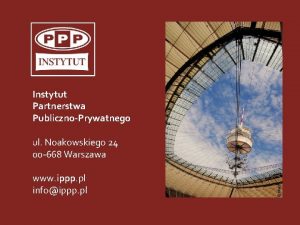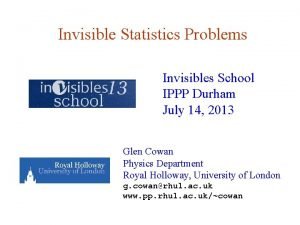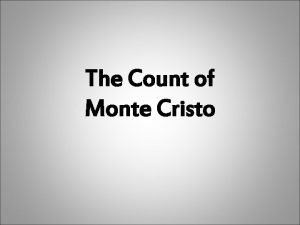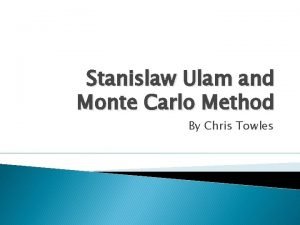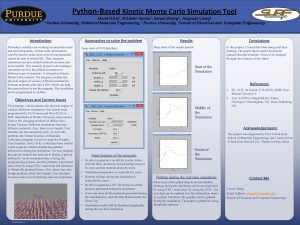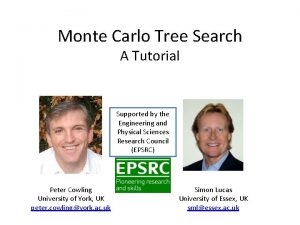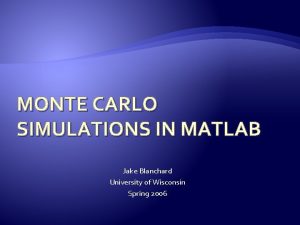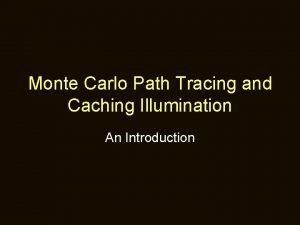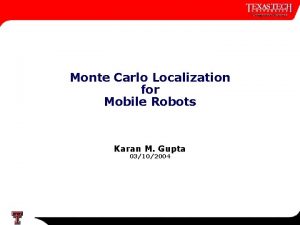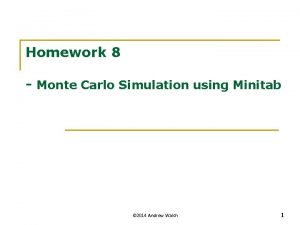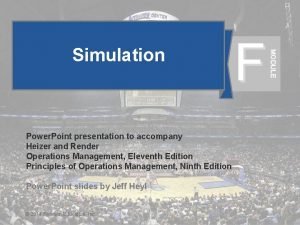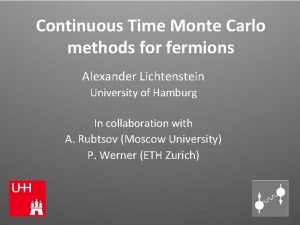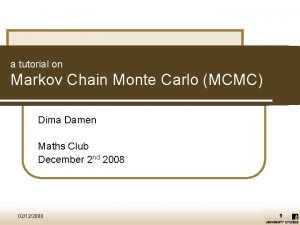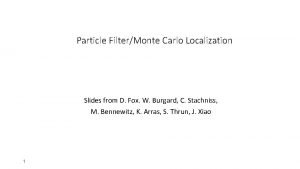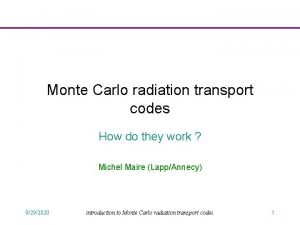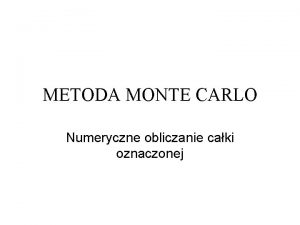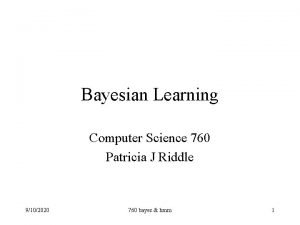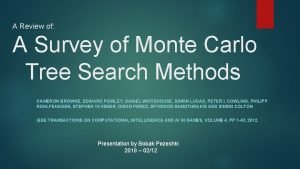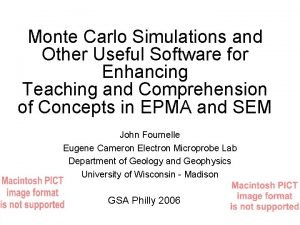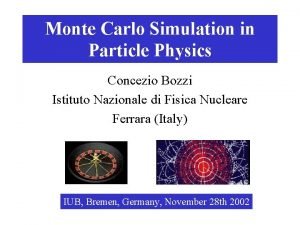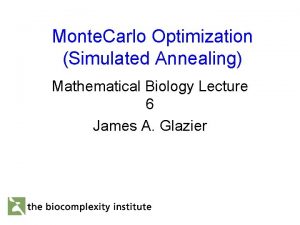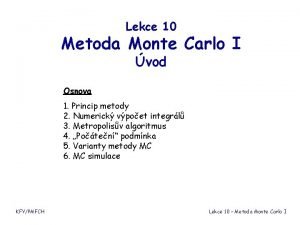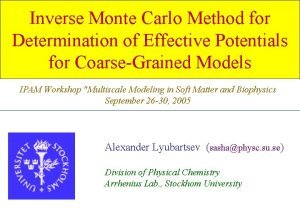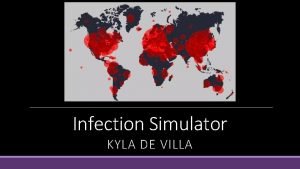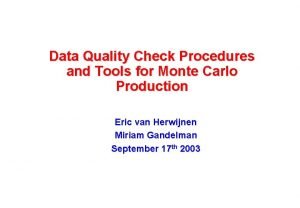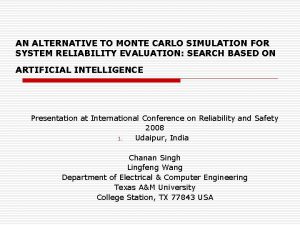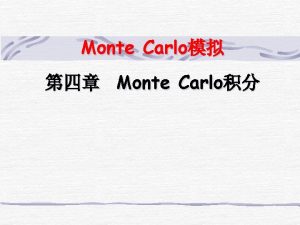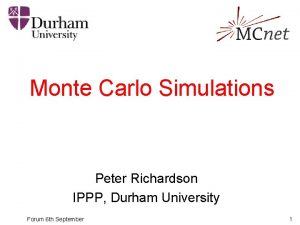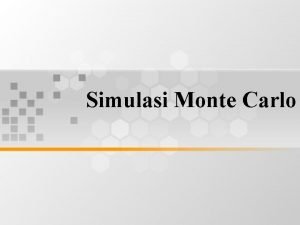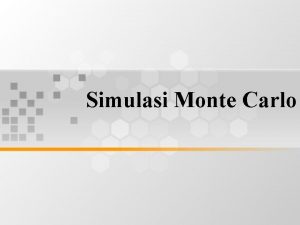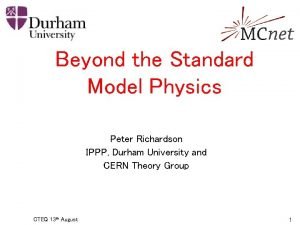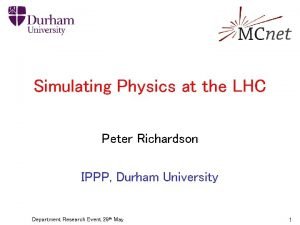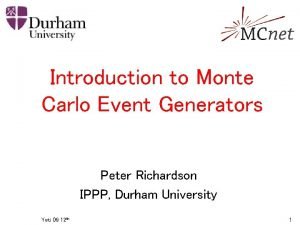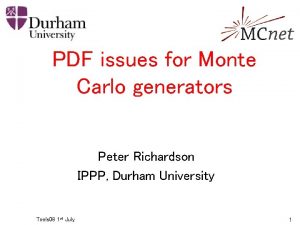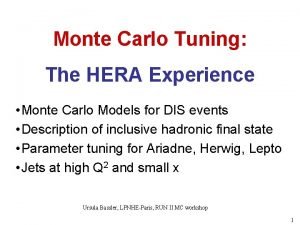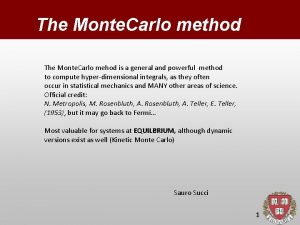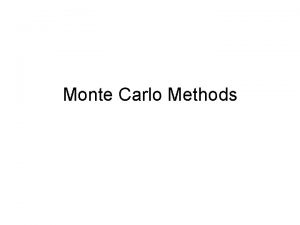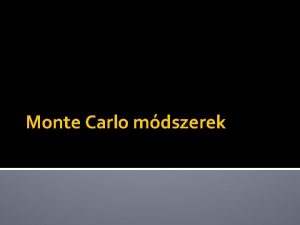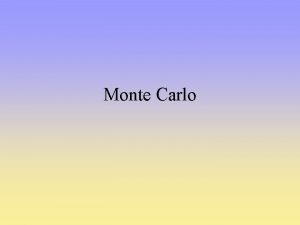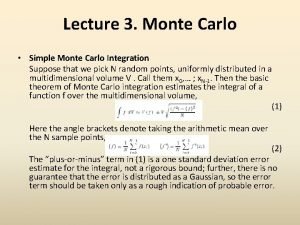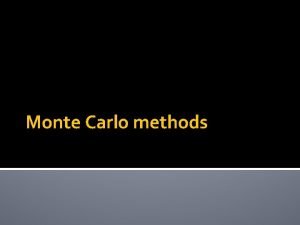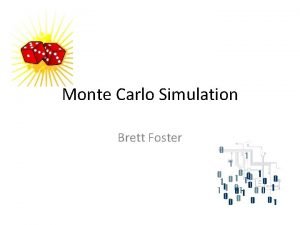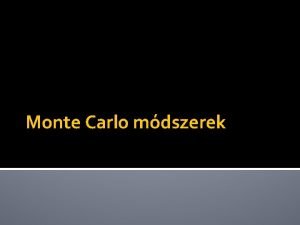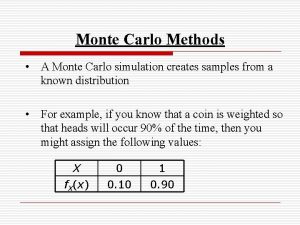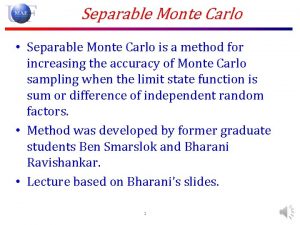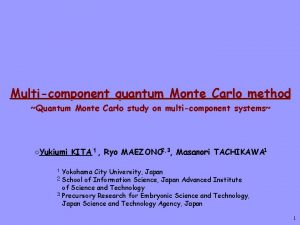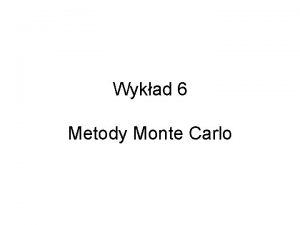Overview of IPPP Monte Carlo Tools Peter Richardson




























- Slides: 28

Overview of IPPP Monte Carlo Tools Peter Richardson IPPP, Durham University IPPP 26 th July 1

Summary • • Introduction Basics of Event Generation Matrix Elements and Perturbative Decays Parton Shower and Matching Hadronization and Tuning Underlying Event Summary IPPP 26 th July 2

Introduction • Monte Carlo event generators are essential both experimental analyses of real data and studies and predictions for future experiments. • As such the programs and their authors are a vital interface between experimental and theoretical communities. • Often they are the only theoretical calculations used in an experimental analyse and it is therefore vital that they are as accurate as possible and include the latest theoretical advances. IPPP 26 th July 3

IPPP 26 th July Hard Perturbative scattering Usually calculated at leading in QCD, electroweak theory some BSM model. Perturbative Decays calculated QCD, State EW or Initial andin. Final parton showers res Finally the unstable hadrons are some theory. large. BSM QCD logs. of the Non-perturbative modelling decayed. hadronization process. odelling of the ft underlying ent ltiple perturbative attering. A Monte Carlo Event

Monte Carlo Projects • At the IPPP we are involved with two of the major simulation packages – HERWIG – SHERPA Richardson, Grellscheid, Hamilton, Gigg, Tully. Krauss, Hoeche • We play a major part in both projects and are involved in many different aspects of the physics. • We are also involved in the CEDAR project (Buckley, Whalley) • and the EU MCnet network. IPPP 26 th July 5

COMIX, a new Matrix element generator • Several independent analyses show clear advantages of Berends-Giele type recursive relations for numerical evaluation of tree-level Matrix Elements • Can be generalised to the full Standard Model, not just QCD. • Employed in new Matrix Element generator Comix, together with a new approach for combined colour sampling. • Current checks in randomly selected QED processes. • Shows clear advantages over commonly used helicity methods (AMEGIC++, Mad. Graph) IPPP 26 th July 6

BSM physics in Herwig++ New method of including new physics in Herwig++, including spin correlations, e- near e- far M. Gigg, P. Richardson hep-ph/0703199 q e+ near e+ far e- near q*L Z* e+ far e*R g* IPPP 26 th July 7

Herwig++ Shower • Following the initial release for e+e- collisions most work has been on – Initial-state shower in hadron collisions – Radiation in the decays of unstable particles – Various matching approaches. Herwig++ with intrinsic p. T compared to CDF data IPPP 26 th July 8

Top Shower and Matrix Element Correction in tgb. W+g JHEP 0702: 069, 2007, Keith Hamilton, Peter Richardson. IPPP 26 th July 9

Nason Approach • One recent idea is an approach to NLO Monte Carlo simulations with only positive weights events, P. Nason JHEP 0411: 040, 2004. • We (K. Hamilton, J. Tully, PR) are looking at this approach. • In particular the treatment of soft radiation (truncated shower) for both NLO simulations and its application in other situations. IPPP 26 th July 10

SHERPA Shower and CKKW • The main SHERPA shower, APACIC++, has been available for some time. • Recently most work has been on – CKKW matching – Catani-Seymour Shower – Colour Dipole Shower IPPP 26 th July 11

SHERPA Colour Dipole Shower IPPP 26 th July 12

SHERPA Colour Dipole Shower IPPP 26 th July 13

SHERPA Catani-Seymour Shower IPPP 26 th July 14

SHERPA Colour Dipole Shower IPPP 26 th July 15

Tuning of Event Generators • Historically the event generators were tuned to LEP data by the LEP collaborations, obviously isn’t going to happen for the new generation of programs. • However it is vital that the new programs are tuned to both LEP, HERA and Tevatron data. • We are involved with this both as part of CEDAR and MCnet and with a new SPG. IPPP 26 th July 16

SHERPA k. T based UE Model • Recently method proposed to describe high-energy jet production in k. T-factorization (IPPP/07/20) • LO BFKL kernel matched to unintegrated parton distributions • Quark production modelled by including LO DGLAP kernels in the soft limit. • Encouraging results for jet production at the Tevatron. • Will be employed for MEgeneration of hard secondary interactions in new Multiple Interaction model for Sherpa. IPPP 26 th July 17

Hadron Decays and QED Radiation • Traditionally the general purpose event generators have relied on external packages for the simulation of – Tau Decays (TAUOLA) – Hadron Decays (QQ, Evt. Gen) – QED Radiation (PHOTOS) • However this can cause problems with interfaces. • Both Herwig++ and SHERPA are moving to sophisticated simulations for all of these. IPPP 26 th July 18

Tau Decays, tgrnt Herwig++ IPPP 26 th July SHERPA 19

Bgpen Herwig++ IPPP 26 th July SHERPA 20

B mixing in SHERPA IPPP 26 th July 21

bgsg in HERWIG IPPP 26 th July 22

YFS • Both HERWIG and SHERPA have moved to an approach based on the YFS formalism for the simulation of QED radiation in particle decays. • This has the advantage that it is systematically improvable by adding the higher order corrections and has proved highly successful in, for example e+e- collisions. • In both cases any number of soft photons are described together with a correction for the hardest emission. IPPP 26 th July 23

YFS Herwig++ K. Hamilton and P. Richardson JHEP 0607: 010, 2006. IPPP 26 th July SHERPA M. Schoenherr 24

Herwig++ Support and Maintenance • On the Herwig++ side we have one long term (core) post, D. Grellscheid, to provide – Core user support – Technical C++ and software expertise to support the design, code management and testing • This will give improved support to the experiments for the LHC and allow other members of the collaboration to concentrate on physics issues. IPPP 26 th July 25

Workshops and Schools • We have had many Monte Carlo related workshops and schools since the start of the IPPP – Physics and Techniques of Event Generators: 1 st MCnet school. (2007) – YETI 06 SM and BSM – C++ Monte Carlo Developers Forum (2005) – YETI 05 – Monte Carlos at Hadron Colliders (2003) – Matrix Elements and Parton Showers (2000) IPPP 26 th July 26

Future • Things are moving fast on both Herwig++ and SHERPA. • For Herwig++ – JIMMY underlying event model (Aug) – BSM physics (Aug) – Hadron decays, tau/mesons (Aug), baryons (Dec) • For SHERPA – – 2 new shower models (Oct) MHV techniques, Berends-Giele subtraction terms (Oct) Cluster Hadronization (Dec) k. T underlying event model (Dec) IPPP 26 th July 27

Summary • Since 2003 we have built a world-leading Monte Carlo group. • The IPPP’s Monte Carlo activities are a vital part of the IPPP programme and provide an essential link to the experimental community. • We are involved in a wide range of event simulation physics and projects using our simulation expertise for physics studies. • In the past few years most of the work has concentrated on C++ and the development of the core physics modules. • Work is now progressing on the physics developments and studies. • Our strength in this area will help us to support the U. K. experimentalists during the LHC. IPPP 26 th July 28
 Ippp
Ippp Ippp durham
Ippp durham Count of monte carlo
Count of monte carlo Stanislaw ulam monte carlo
Stanislaw ulam monte carlo Simulasi monte carlo ppt
Simulasi monte carlo ppt Mnemstudio
Mnemstudio Kinetic monte carlo python
Kinetic monte carlo python Connect 4 monte carlo tree search
Connect 4 monte carlo tree search Monte carlo integration matlab
Monte carlo integration matlab Monte carlo ray tracing
Monte carlo ray tracing Monte carlo localization for mobile robots
Monte carlo localization for mobile robots Minitab monte carlo
Minitab monte carlo Monte carlo simulation advantages and disadvantages ppt
Monte carlo simulation advantages and disadvantages ppt Continuous time monte carlo
Continuous time monte carlo Mcmc tutorial
Mcmc tutorial Monte carlo localization python
Monte carlo localization python Monte carlo radiation transport
Monte carlo radiation transport Metoda monte carlo algorytm
Metoda monte carlo algorytm Monte carlo search tree
Monte carlo search tree Monte carlo search tree
Monte carlo search tree Monte carlo simulation freeware
Monte carlo simulation freeware Concezio bozzi
Concezio bozzi Monte carlo optimization
Monte carlo optimization Metoda monte carlo
Metoda monte carlo Inverse monte carlo
Inverse monte carlo Villa monte carlo
Villa monte carlo Monte carlo data quality
Monte carlo data quality Alternative to monte carlo simulation
Alternative to monte carlo simulation Rembrandt self protrait
Rembrandt self protrait
